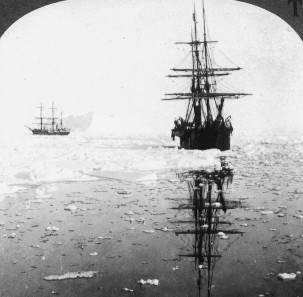Martin Frobisher
Today, we go after gold -- and gain education instead. The University of Houston's College of Engineering presents this series about the machines that make our civilization run, and the people whose ingenuity created them.
The early exploration of the New World was full of misadventure. Take Frobisher's quest for the Northwest Passage:
Martin Frobisher, born in 1535, took up sailing at 19. He became an excellent pirate. Piracy against Spain was legal in England, but Frobisher was too good at it. He got in the way of Queen Elizabeth's negotiations with Spain. She finally had to draft his talents into the English Navy. Then he met Elizabeth's counselor, John Dee. Dee helped convince Frobisher that he could find a Northwest passage to Asia through Arctic Canada.
In 1576, Frobisher set out in three tiny ships to look for China. The largest had only an 18-man crew. Frobisher got to Greenland and thought it was one of the Faeroe Islands. A storm sank one of his three ships. Another defected back to England. He finally reached two large bodies of land. He thought the northern one must be Asia and the southern one America.
Actually he'd found a 150-mile bay running into Baffin Island. On land he met Inuit Indians who laughed at his alien band. They'd been hearing about Europeans since Leif Ericson.
Then Inuits kidnapped five of his crew. Frobisher snatched up some mineral samples, took a hostage, and headed home. Back in England, one of his samples looked like it might contain gold. The Royal assayer said no -- it was fool's gold. But England was hungry for the kind of wealth Spain had been looting out of Central America. That rock had to be gold. Finally they found an Italian assayer who said it was low-grade gold ore.
So merchants formed a Cathay Company and sent Frobisher back to the Arctic. The Queen named him the Admiral-of-Cathay. He set up a small fort on Baffin Island. He learned about the Inuits. This time he brought 200 tons of ore back to England. When it proved worthless, his backers assumed Frobisher had just mined in the wrong place. They outfitted a third and much larger voyage.
They sent 15 ships to build a colony. This time Frobisher realized he'd found an Arctic bay, not China. When he brought back 1100 tons of worthless ore, that should've been IT. But it wasn't. They asked him to make yet a fourth voyage. This time he said, "No!" He wanted to find the Northwest Passage, not set up trading posts. He wanted action. Later, he fought the Spanish Armada with Drake. He finally died in an action against the French.
Meanwhile we'd learned geography, anthropology, bad-weather sailing and survival -- not because Frobisher was a teacher or a scholar, but because he was a catalyst. He was a coarse, combative man, and he took part in a great folly. Sustained risk was the only life he know how to live. And we came out richer for that.
I'm John Lienhard, at the University of Houston, where we're interested in the way inventive minds work.
(Theme music)
McFee, W., The Life of Sir Martin Frobisher. New York: Harper & Brothers Pubs, 1928.
Stefansson, V., The Three Voyages of Martin Frobisher. Vols I and II, London: The Argonaut Press, 1938.
See also the article on Frobisher in the Dictionary of National Biography and a recent review of two new books: Gogg, G.E., Science, Vol. 264, 13 May, 1994, pp. 1021-1024. [The books are Archeology of the Frobisher Voyages. (Fitzhugh, L.W., and Olin, J., eds.) Washington, DC: Smithsonian Institution Press, 1993; and The Meta Incognita Project. Contributions to Field Studies, (Alsford, S., ed.) Quebec: Canadian Museum of Civilization, 1993.]

Stereopticon photo courtesy of Margaret Culbertson
Whaling vessels in Frobisher's arctic waters near Baffin Island in the early 20th century